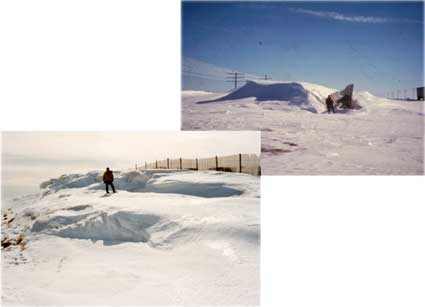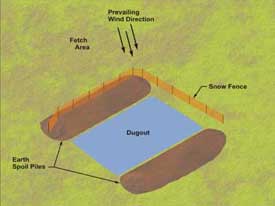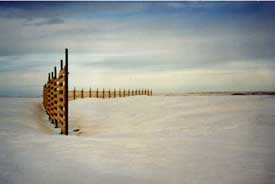You are here: PFRA Online > Water Supply
Trapping Snow To Increase the Water Supply of Dugouts
The water supply of some surface water dugouts can be enhanced using effectively placed snow fences. The benefits of
snow fences depend on the amount of snowfall. If an area receives no snowfall, the snow fence provides no benefit.
However, a single snowstorm, along with a properly placed snow fence, can improve the water supply.
A properly placed and constructed snow fence can trap a significant amount of snow and as a result can increase the water supply to a dugout.

The importance of snow management is quickly understood when one considers that, on average, 75% of annual surface runoff to most water storage projects is from spring snowmelt. For small water storage projects such as dugouts, the water supply is almost entirely based on snowmelt runoff.
On average, only 25-30% of annual precipitation across the Canadian Prairies is in the form of snow. Redistribution of snow by the wind can significantly reduce or increase the effect of this precipitation. As a result, the effective trapping of snow with snow fences can be beneficial in securing a water supply.
Design and installation criteria for snow fences used to trap snow and enhance the water supply to water storage projects are as follows:
- 1. Snow Fence Type
- Several types of snow fences are available: the commonly-seen vertical slat snow fence, the plastic snow fence, and the "Wyoming" style snow fence. Studies indicate that the Wyoming style snow fence, is the most efficient type of snow fence followed closely by the plastic snow fence, and then the somewhat less efficient vertical slat snow fence. A snow fence constructed of horizontal boards having a 50% porosity is 25% more efficient than one constructed of vertical boards. If constructed properly, the Wyoming style snow fence can be fairly durable. However, the Wyoming style snow fence can be costly and labor intensive to build. The plastic snow fence has a 50% porosity, and as a result is efficient, reasonably priced and relatively easy to install. The plastic snow fence, however, does not stand up to cattle rubbing up against it.
- The plastic snow fence established on the upwind side of the dugout can be attached on wooden or steel fence posts using slats. The posts shown are approximately 3 metres apart and the plastic fence is 1.8 metres. A gap of 0.20 metres was maintained between the fence and the ground.


- The Wyoming style snow fence commonly used in the state of Wyoming utilizes horizontal boards with spacings equal to the width of the board, achieving a 50% porosity. The face of the fence is also slightly tilted so that the cattle cannot rub up against the fence. The design of the fence shown in the photo can be modified to achieve the same snow trapping capability based on available material and desired durability. The fence shown is approximately 1.8 metres high and a gap of 0.20 metres was maintained between the fence and ground. The dugout is located to the right of the snow fence.
- 2. Snow Fence Height
- The height of a snow fence is often a balance between cost and efficiency. The snow trapping capacity of a snow fence is proportional to the height of the fence, and the cost increases with the height. The trapping efficiency remains greater than 80% until a fence is approximately 70 to 80% full and then decreases quickly. A fence height of 2 to 2.5 metres would be reasonable for most areas on the Prairies; however, cost could be a factor. The Wyoming style fence could be built to any reasonable height, however lumber costs can be fairly high. The plastic snow fence is available in 1.2-metre and 1.8-metre heights and is reasonably priced. To test the effect of snow trapping for a particular dugout, a 1.2-metre plastic snow fence could be established at a reasonable cost. If the snow fence appears to be filled and snow is blowing overtop of the snow fence, a second 1.2-metre fence could be added and placed above the existing fence. If the snow fence is placed on an earth spoil pile next to the dugout, the effective height of the snow fence may be increased.
- 3. Locate the snow fence on the upwind side, so that the trapped snow is deposited in the dugout.
- A large portion of the runoff from a melting snow drift can be lost to seepage if the drift forms too far from the water body. To reduce the losses, place the snow fence on the upwind side of the dugout so that the drift forms in the dugout. In cases where an earth spoil pile is located alongside the upwind side of the dugout, the snow fence should be set on top of the spoil pile.
- Ideally the snow fence and long side of the dugout are or can be located perpendicular to the prevailing wind direction. In most cases, the direction of the prevailing wind can be determined by observing the orientation of snow drifts along obstructions. However, studies have shown that a snow fence is no less effective if the wind direction deviates up to 25 degrees from the perpendicular to the snow fence. So for some existing dugouts, a choice exists between placing the snow fence along the long side of the dugout, which may not be quite perpendicular to the prevailing wind direction, or placing the snow fence perpendicular to the prevailing wind direction which may not parallel the longest side of the dugout. Pending further research, it would be advisable to locate the snow fence along the length of the dugout so that the drift forms in the dugout to minimize seepage loss, rather than trying to keep the snow fence perpendicular to the prevailing wind direction to maximize the efficiency of the snow fence.
- In some cases, where a dugout is not perpendicular to the orientation of the wind and if the budget allows, the snow fence could be placed on two upwind sides of the dugout as shown in the schematic below. In the extreme case, a snow fence could be placed around the entire perimeter of the dugout. Although the amount of snow captured in such a case may increase because of multi-directional blowing snow, this option may be fairly expensive.
 The schematic presents an existing dugout where the prevailing winds are diagonal to the length of the dugout and the earth spoil piles were placed along the length of the dugout. In this case place the snow fence along two sides of the dugout and on top of the earth spoil pile. The schematic presents an existing dugout where the prevailing winds are diagonal to the length of the dugout and the earth spoil piles were placed along the length of the dugout. In this case place the snow fence along two sides of the dugout and on top of the earth spoil pile.
- 4. The upwind fetch length of the dugout should be sufficient to fill the snow fence with snow.
- The "fetch" is the length of the area serving as a source of blowing snow to a downstream location. The fetch boundary or limit is any obstacle (e.g. a shelterbelt along a fence line) beyond which no snow is transported. The required fetch length will vary from area to area, depending on the land use, snowfall and wind velocities. If the fetch area is under vegetative cover, there has to be sufficient snowfall to "fill" the vegetative cover before the wind is effective in transporting the snow.
 The Wyoming style snow fence is located on the upwind side of the snow covered dugout. The open grassland area located on the upwind side of the dugout is referred to as the fetch area. The prevailing wind direction is from the top left hand side of the photo to the bottom right side. The Wyoming style snow fence is located on the upwind side of the snow covered dugout. The open grassland area located on the upwind side of the dugout is referred to as the fetch area. The prevailing wind direction is from the top left hand side of the photo to the bottom right side.
- 5. A gap of 10 to 15% of the total snow fence height between the ground and fence should be maintained.
- A gap at the bottom of the snow fence reduces the tendency of the snow fence to become buried in the drift. Burial of the snow fence reduces the effective fence height and thus reduces storage capacity of the fence. Burial also often causes structural damage to the fence because of the large forces exerted by snow settlement and creep. A gap that is too wide reduces the storage capacity and efficiency of the snow fence.
 The bottom gap on the Wyoming style snow fence reduces the tendency of the snow fence to be buried. The dugout is located to the right of the snow fence and the snow drift has almost filled an otherwise near empty dugout. The bottom gap on the Wyoming style snow fence reduces the tendency of the snow fence to be buried. The dugout is located to the right of the snow fence and the snow drift has almost filled an otherwise near empty dugout.
|